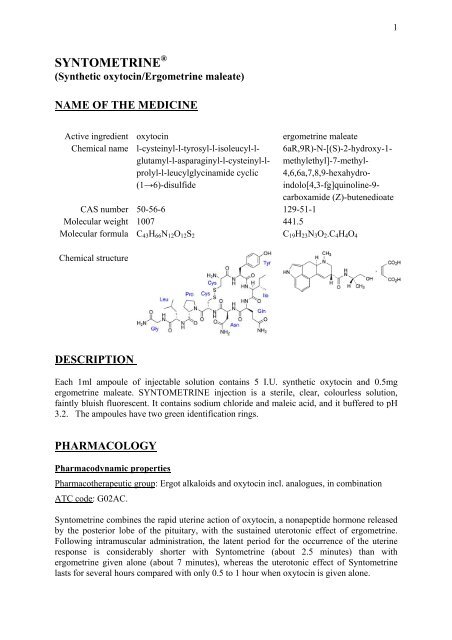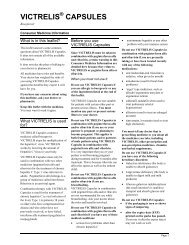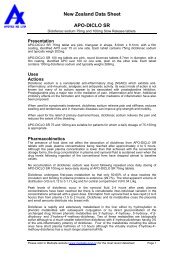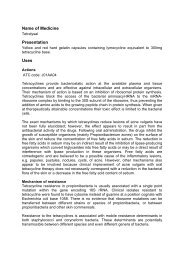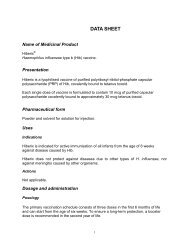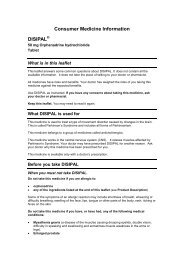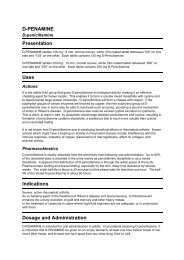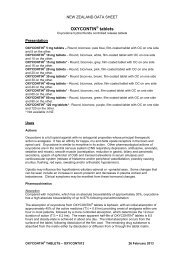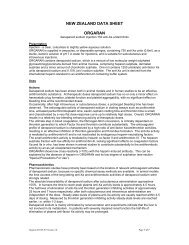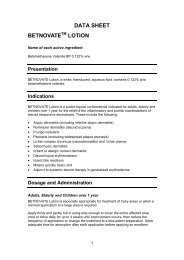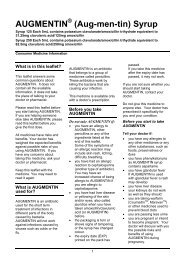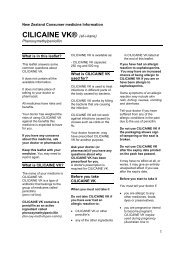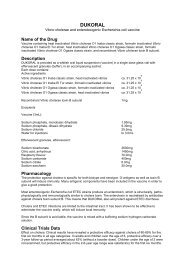SYNTOMETRINE - Medsafe
SYNTOMETRINE - Medsafe
SYNTOMETRINE - Medsafe
Create successful ePaper yourself
Turn your PDF publications into a flip-book with our unique Google optimized e-Paper software.
<strong>SYNTOMETRINE</strong> ®<br />
(Synthetic oxytocin/Ergometrine maleate)<br />
NAME OF THE MEDICINE<br />
Active ingredient oxytocin ergometrine maleate<br />
Chemical name l-cysteinyl-l-tyrosyl-l-isoleucyl-lglutamyl-l-asparaginyl-l-cysteinyl-lprolyl-l-leucylglycinamide<br />
cyclic<br />
(1→6)-disulfide<br />
6aR,9R)-N-[(S)-2-hydroxy-1methylethyl]-7-methyl-4,6,6a,7,8,9-hexahydroindolo[4,3-fg]quinoline-9carboxamide<br />
(Z)-butenedioate<br />
CAS number 50-56-6 129-51-1<br />
Molecular weight 1007 441.5<br />
Molecular formula C43H66N12O12S2<br />
C19H23N3O2.C4H4O4<br />
Chemical structure<br />
DESCRIPTION<br />
Each 1ml ampoule of injectable solution contains 5 I.U. synthetic oxytocin and 0.5mg<br />
ergometrine maleate. <strong>SYNTOMETRINE</strong> injection is a sterile, clear, colourless solution,<br />
faintly bluish fluorescent. It contains sodium chloride and maleic acid, and it buffered to pH<br />
3.2. The ampoules have two green identification rings.<br />
PHARMACOLOGY<br />
Pharmacodynamic properties<br />
Pharmacotherapeutic group: Ergot alkaloids and oxytocin incl. analogues, in combination<br />
ATC code: G02AC.<br />
Syntometrine combines the rapid uterine action of oxytocin, a nonapeptide hormone released<br />
by the posterior lobe of the pituitary, with the sustained uterotonic effect of ergometrine.<br />
Following intramuscular administration, the latent period for the occurrence of the uterine<br />
response is considerably shorter with Syntometrine (about 2.5 minutes) than with<br />
ergometrine given alone (about 7 minutes), whereas the uterotonic effect of Syntometrine<br />
lasts for several hours compared with only 0.5 to 1 hour when oxytocin is given alone.<br />
1
These properties make Syntometrine i.m. suitable for the active management of the third<br />
stage of labour (see ‘Dosage’) and for the prevention or treatment of postpartum<br />
haemorrhage, particularly in situations where for any reason the intravenous administration<br />
of an uterotonic agent is impracticable.<br />
Oxytocin is a cyclic nonapeptide that is obtained by chemical synthesis. This synthetic form<br />
is identical to the natural hormone that is stored in the posterior pituitary and released into the<br />
systemic circulation in response to suckling and labor. Oxytocin stimulates the smooth<br />
muscle of the uterus, more powerfully towards the end of pregnancy, during labor, and<br />
immediately postpartum. At these times, the oxytocin receptors in the myometrium are<br />
increased. The oxytocin receptors are G-proteins coupled receptors. Activation of receptor by<br />
oxytocin triggers release of calcium from intracellular stores and thus leads to myometrial<br />
contraction Oxytocin elicits rhythmic contractions in the upper segment of the uterus, similar<br />
in frequency, force and duration to those observed during labor. Being synthetic, oxytocin in<br />
Syntometrine® does not contain vasopressin, but even in its pure form oxytocin possesses<br />
some weak intrinsic vasopressin-like antidiuretic activity.<br />
Ergometrine produces sustained tonic uterine contraction via agonist or partial agonist effects<br />
at myometrial 5-HT2 receptors and alpha-adrenergic receptors. Both upper and lower uterine<br />
segments are stimulated to contract in a tetanic manner. Unlike oxytocin ergometrine has an<br />
effect on the non-pregnant uterus. Ergometrine inhibits prolactin secretion and in turn can<br />
reduce lactation. Compared with other ergot alkaloids, effects of ergometrine on<br />
cardiovascular and central nervous system are less pronounced.<br />
Pharmacokinetics<br />
Oxytocin<br />
Absorption<br />
Oxytocin is rapidly absorbed from the IM site.<br />
Distribution<br />
The steady-state volume of distribution determined in 6 healthy men after IV injection is 12.2<br />
L or 0.17 L/kg. Plasma protein binding is negligible for oxytocin. It crosses the placenta in<br />
both directions. Oxytocin may be found in small quantities in mother’s breast milk.<br />
Biotransformation / Metabolism<br />
Oxytocinase is a glycoprotein aminopeptidase that is produced during pregnancy. It is<br />
capable of degrading oxytocin. It is produced both by the mother and the foetus. The liver<br />
and kidney play a major role in metabolizing and clearing oxytocin from the plasma. Thus,<br />
the liver, kidney and systemic circulation contribute to the biotransformation of oxytocin.<br />
Elimination<br />
The plasma half life of oxytocin ranges from 3 minutes to 20 minutes. The metabolites are<br />
excreted in urine whereas less than 1 % of the oxytocin is excreted unchanged in urine. The<br />
metabolic clearance rate amounts to 20 mL/kg/min in the pregnant woman<br />
2
Ergometrine<br />
Absorption<br />
Ergometrine is absorbed rapidly after IM injection. The latent period for occurence of the<br />
uterine response is about 7 minutes.<br />
Distribution<br />
The average steady state volume of distribution of ergometrine in healthy man is reported to<br />
be 1.04 L/kg. The plasma protein binding of ergometrine is unknown. Ergometrine is known<br />
to cross the placenta and its clearance from fetus is slow. Concentrations of ergometrine<br />
achieved in fetus are not known. Ergometrine is also expected to be excreted in the breast<br />
milk and to reduce milk secretion.<br />
Metabolism/Biotransformation<br />
Ergometrine is mainly metabolized in the liver by hydroxylation and glucuronic acid<br />
conjugation and possibly N-demethylation. Like other ergot alkaloids it is a substrate for<br />
CYP3A4 enzymes.<br />
Elimination<br />
The plasma half life of ergometrine is reported to be in the range of 30 minutes to 120<br />
minutes. When administered orally, the drug is mainly eliminated with the bile into the faeces<br />
as 12 hydroxyergometrine glucuronide. It is eliminated unchanged in the urine and can be<br />
detected up to 8 hours after injection.<br />
INDICATIONS<br />
• Active management of the third stage of labour (as a means to promote separation of<br />
the placenta and to reduce blood loss)<br />
• Prevention and treatment of postpartum haemorrhage associated with uterine atony<br />
CONTRAINDICATIONS<br />
• Hypersensitivity to any of the components<br />
• Pregnancy and labour (induction of labour, first stage labour and second stage labour<br />
prior to the delivery of the anterior shoulder) due to the risk of uterine hypertonus and<br />
associated foetal complications (see Pregnancy and Lactation)<br />
• Severe hypertension, pre-eclampsia, eclampsia.<br />
• Severe cardiac disorders<br />
• Severe hepatic or renal impairment<br />
• Occlusive vascular disease<br />
• Sepsis<br />
PRECAUTIONS<br />
In breech presentation and other abnormal presentations, Syntometrine should not be given<br />
until after delivery of the child is completed. When Syntometrine is used for the<br />
3
management of the third stage of labour the possibility of multiple pregnancy must be<br />
assessed; Syntometrine should not be given until the last child has been delivered (see<br />
Pregnancy and Lactation).<br />
Syntometrine has the potential to cause serious adverse drug reactions in breastfed<br />
newborns/infants. Postpartum women receiving Syntometrine should avoid breastfeeding at<br />
least 12 hours after the administration. Milk secreted during this period should be expressed<br />
and discarded (see Pregnancy and Lactation).<br />
Active management of the third stage of labour requires expert obstetric supervision.<br />
If in the treatment of postpartum haemorrhage, bleeding is not arrested by the injection of<br />
Syntometrine, the possibility of a retained placental fragment, or soft tissue injury (cervical<br />
or vaginal laceration), or of a clotting defect should be considered and appropriate measures<br />
taken before a further injection is given.<br />
Ergot alkaloids are substrates of CYP3A4. The concomitant use of Syntometrine with strong<br />
CYP3A4 inhibitors such as macrolide antibiotics (e.g. troleandomycin, erythromycin,<br />
clarithromycin), HIV protease or reverse transcriptase inhibitors (e.g. ritonavir, indinavir,<br />
nelfinavir, delavirdine), or azole antifungals (e.g. ketoconazole, itraconazole, voriconazole)<br />
should be avoided, since this can result in an elevated exposure to methylergometrine and<br />
ergot toxicity (vasospasm and ischemia of the extremities and other tissues). Caution should<br />
be exercised when Syntometrine is used concurrently with other vasoconstrictors or other<br />
ergot alkaloids. Concurrent use of vasoconstrictors and Syntometrine after delivery during<br />
anesthesia may lead to severe postpartum hypertension. Methylergometrine may enhance the<br />
vasoconstrictor/vasopressor effects of other drugs such as triptans (5HT1B/1D receptor<br />
agonists), sympathomimetics (including those in local anesthetics), beta-blockers or other<br />
ergot alkaloids (see INTERACTIONS WITH OTHER MEDICINES).<br />
Caution is required when using Syntometrine alone or in combination with prostaglandins<br />
and their analogues in the treatment of postpartum atonic uterine haemorrhage (see<br />
INTERACTIONS WITH OTHER MEDICINES).<br />
Caution is required in patients with mild or moderate hypertension, cardiac disorders, or<br />
hepatic or renal impairment.Severe forms are contraindicated (see CONTRAINDICATIONS<br />
and PHARMACOLOGY). Patients with coronary artery disease may be more susceptible to<br />
myocardial ischemia and infarction caused by ergometrine-induced vasospasm (see<br />
ADVERSE EFFECTS). Caution is also required in patients with respiratory disease, chronic<br />
anaemia and toxaemia of pregnancy.<br />
Oxytocin should be considered as potentially arrhythmogenic. Caution is required when<br />
using Syntometrine in patients with other risk factors for torsades de pointes such as drugs<br />
which prolong the QT interval or in patients with a history of long QT syndrome (see<br />
INTERACTIONS WITH OTHER MEDICINES).<br />
4
Use in Pregnancy: (Category C)<br />
Ergometrine has potent uterotonic activity. Therefore Syntometrine is contraindicated during<br />
pregnancy and during induction of labour; first stage labour and second stage labour prior to<br />
the delivery of the anterior shoulder (see CONTRAINDICATIONS).<br />
In breech presentation and other abnormal presentations, Syntometrine should not be given<br />
before delivery of the child is completed, and in multiple birth not before the last child has<br />
been delivered.<br />
Use in Lactation:<br />
Ergometrine is secreted into milk and the inhibitory effect of ergometrine on prolactin can<br />
cause a reduction in milk secretion. Syntometrine has the potential to cause serious adverse<br />
drug reactions in breastfed newborns/infants. Postpartum women receiving Syntometrine<br />
should avoid breastfeeding at least 12 hours after the administration. Milk secreted during<br />
this period should be discarded. Breast-feeding should be discontinued in case where<br />
repeated postpartum administration of Syntometrine is necessary. Drugs used to suppress<br />
lactation (e.g bromocriptine) can be taken 12 hours after the Syntometrine injection.<br />
Renal impairment/hepatic impairment<br />
No studies have been performed in patients with renal or hepatic impairment. However<br />
considering the metabolic pathway of ergometrine and oxytocin, use is contraindicated in<br />
severe hepatic and renal impairment and caution is required in mild or moderate hepatic and<br />
renal impairment.<br />
Paediatric patients<br />
No studies have been performed in paediatric patients. Syntometrine<br />
is not indicated for use in children.<br />
INTERACTIONS WITH OTHER MEDICINES<br />
Interactions related to both oxytocin and ergometrine administration<br />
Interactions resulting in concomitant use are not recommended (see PRECAUTIONS)<br />
Vasoconstrictors/Sympathomimetics<br />
Syntometrine may enhance the pressor effect of vasoconstrictor drugs and sympathomimetics<br />
even those contained in local anaesthetics.<br />
Prostaglandins and their analogues<br />
Prostaglandins and their analogues facilitate contraction of the myometrium hence<br />
Syntometrine can potentiate the uterine action of prostaglandins and analogues and vice<br />
versa.<br />
Interactions to be considered<br />
5
Inhalation anesthetics<br />
Inhalation anesthetics (e.g. halothane, cyclopropane, sevoflurane, desflurane, isoflurane) have<br />
a relaxing effect on uterus and produce a notable inhibition of uterine tone and thereby,<br />
anaesthesia may diminish the uterotonic effect of Syntometrine.<br />
Interactions related to oxytocin administration<br />
Interactions resulting in concomitant use not recommended (see PRECAUTIONS)<br />
Drugs prolonging the QT interval<br />
Oxytocin should be considered as potentially arrhythmogenic, particularly in patients with<br />
other risk factors for torsades de pointes such as drugs which prolong the QT interval or in<br />
patients with history of long QT syndrome.<br />
Interactions related to ergometrine administration<br />
Interactions resulting in concomitant use not recommended (see PRECAUTIONS)<br />
CYP3A4 inhibitors<br />
Strong CYP3A4 inhibitors such as protease inhibitors, macrolide antibiotics (e.g.<br />
troleandomycin, erythromycin, clarithromycin), HIV protease or reverse transcriptase<br />
inhibitors (e.g. ritonavir, indinavir, nelfinavir, delavirdine), azole antifungals (e.g.<br />
ketoconazole, itraconazole, voriconazole), quinolones might raise the levels of ergot<br />
derivatives, which may lead to ergotism. Combined use with Syntometrine should be<br />
avoided.<br />
Other weaker CYP3A4 inhibitors (e.g cimetidine, delavirdine, grapefruit juice, quinupristin,<br />
dalfopristin) might interact similarly, although possibly to a lesser extent.<br />
Ergot alkaloids/ergot derivatives<br />
Concurrent use of other ergot alkaloids (e.g methysergide) and other ergot derivatives can<br />
increase the risk of severe and persistent spasm of major arteries in some patients.<br />
Triptans<br />
Additive vasoconstriction may occur when ergometrine is concomitantly given with triptans<br />
(e.g. sumatriptan, zolmitriptan, rizatriptan, almotriptan, eletriptan).<br />
Beta-blockers<br />
Concomitant administration with beta-blockers may enhance the vasoconstrictive action of<br />
ergot alkaloids.<br />
Glyceryl trinitrate and other antianginal drugs<br />
Ergometrine produces vasoconstriction and can be expected to reduce the effect of glyceryl<br />
trinitrate and other antianginal drugs.<br />
Interactions to be considered<br />
CYP3A4 inducers<br />
CYP3A4 inducers (e.g nevirapine, rifampicin) may reduce the clinical effect of ergometrine.<br />
6
ADVERSE EFFECTS<br />
The following adverse drug reactions have been reported during post-approval use of<br />
Syntometrine via spontaneous case reports and literature cases. Because these reactions are<br />
reported voluntarily from a population of uncertain size and subject to confounding factors, it<br />
is not possible to reliably estimate their frequency which is therefore quoted as not known.<br />
Adverse drug reactions are listed according to system organ classes in MedDRA. Within each<br />
system class organ class, ADRs are presented in order of decreasing seriousness.<br />
Gastrointestinal disorders: nausea, vomiting, abdominal pain<br />
Nervous system disorders: cerebro-vascular accident: headache, dizziness<br />
Skin and subcutaneous tissue<br />
disorders: rash<br />
Vascular disorders: hypertension<br />
Cardiac disorders: myocardial infarction, coronary arteriospasm: bradycardia,<br />
cardiac arrhythmias, chest pain (see PRECAUTIONS)<br />
Immune system disorders: anaphylactoid reactions associated with dyspnoea, hypotension,<br />
collapse or shock.<br />
DOSAGE AND ADMINISTRATION<br />
Active management of third stage of labour:<br />
1 mL intramuscularly following delivery of the anterior shoulder, or immediately after<br />
delivery of the child. Expulsion of the placenta, which is normally separated by the first<br />
strong uterine contraction following the injection of Syntometrine should be manually<br />
assisted by applying gentle fundal pressure.<br />
Prevention and treatment of postpartum haemorrhage:<br />
1 mL i.m. following expulsion of the placenta, or when bleeding occurs.<br />
If necessary, the injection of 1 mL may be repeated after an interval of not less than 2 hours.<br />
The total dose given within 24 hours should not exceed 3 mL.<br />
Intravenous administration of Syntometrine (0.5 to 1 mL by slow injection) is possible, but<br />
not generally recommended. It is advisable to monitor blood pressure during intravenous<br />
administration.<br />
OVERDOSAGE<br />
No cases of overdosage with Syntometrine in adults have so far been reported.<br />
Accidental administration to the newborn infant has been reported. In these accidental<br />
neonatal overdosage cases, symptoms such as respiratory depression, convulsions, cyanosis,<br />
oliguria, hypertonia, and arrhythmia have been reported. Treatment should be symptomatic;<br />
in most cases respiratory and cardiovascular support has been required. Fatal cases have been<br />
reported in the absence of adequate treatment.<br />
7
Symptoms<br />
The symptoms most likely to occur would be those of acute ergometrine intoxication: nausea,<br />
vomiting, hypertension or hypotension, vasospastic reactions, respiratory depression,<br />
convulsions, coma. Treatment would have to be symptomatic.<br />
Treatment<br />
Inadvertent administration to the newborn infant has proved fatal. Other than general<br />
resuscitative measures, no treatment is available.<br />
For information on the management of overdose, contact the National Poisons Centre<br />
(telephone 0800 POISON or 0800 764 766).<br />
PRESENTATION AND STORAGE CONDITIONS<br />
Presentation<br />
Each pack contains 5 ampoules of 1 ml.<br />
Storage<br />
Store at 2-8°C (Refrigerate, do not freeze). Protect from light<br />
MEDICINE CLASSIFICATION<br />
Prescription Medicine<br />
NAME AND ADDRESS OF THE SPONSOR<br />
Novartis New Zealand Limited<br />
Private Bag 65904<br />
Mairangi Bay Auckland 0754<br />
Building G, 5 Orbit Drive<br />
Rosedale Auckland 0632<br />
Telephone: 09 361 8100<br />
DATE OF MOST RECENT AMENDMENT<br />
10 June 2011<br />
8


